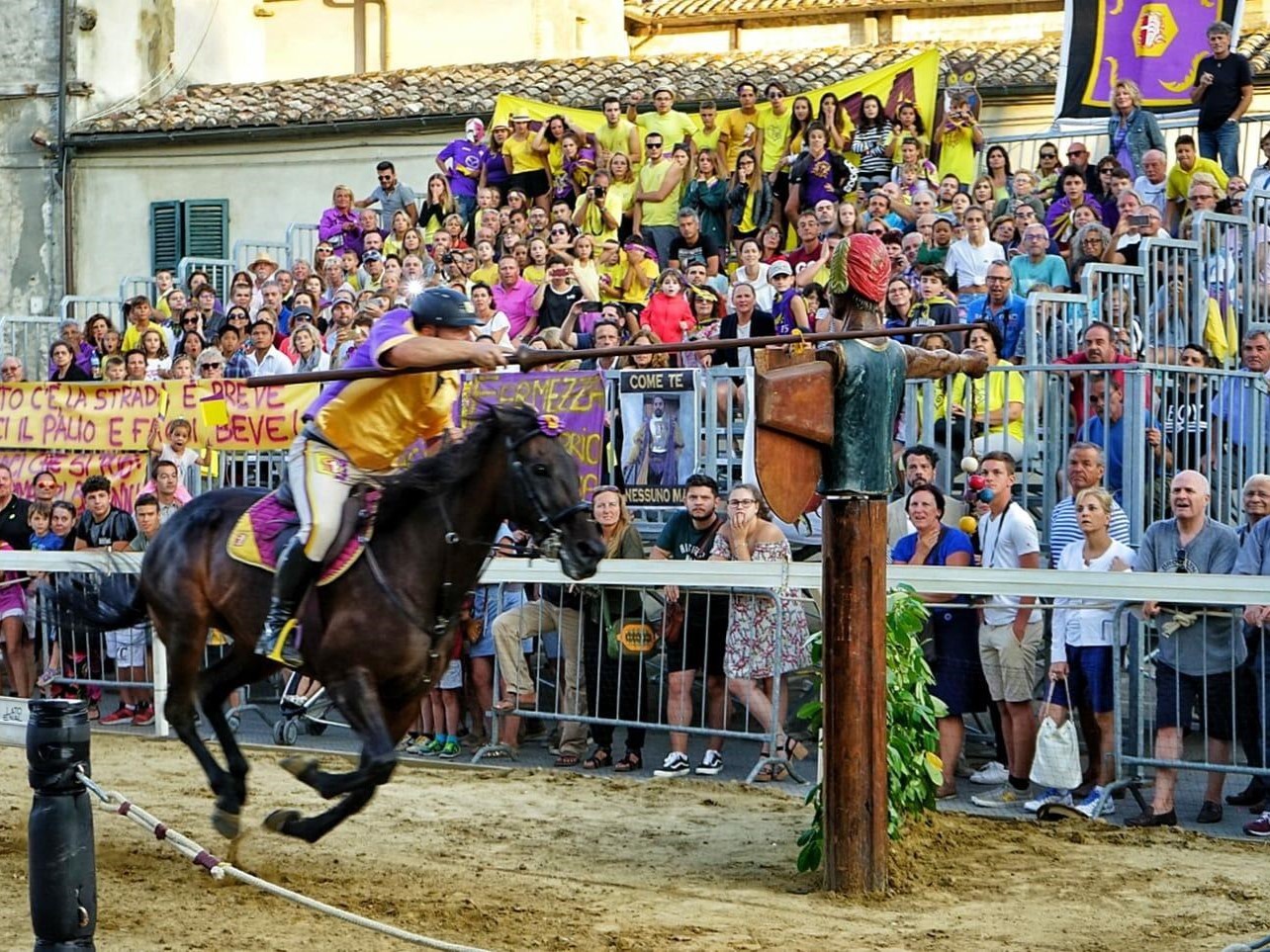
 We the Italians Editorial Staff
We the Italians Editorial Staff
Italian traditions: Giostra del Saracino of Sarteano, a historic knightly tournament
- WTI Magazine #186 Apr 18, 2025
-

 We the Italians Editorial Staff
We the Italians Editorial Staff
The Giostra del Saracino of Sarteano is a knightly tournament with ancient tradition that has been held in Sarteano, in the province of Siena, for time immemorial. Five knights, known as "giostratori," representing the five districts into which the town is divided, compete for the coveted palio.
Called to charge, each mounted knight, galloping and holding a lance in their right hand, must insert a 6-centimeter diameter ring placed on the shield of a saracen effigy, called "buratto." After five races, known as "carriere," the giostratore of the district that has earned the most valid rings wins. In case of a tie, a tiebreaker is held with no set limit.
The Giostra del Saracino is an evolution of the ancient and bloody knightly tournaments that have existed since the time of Charlemagne and the Crusades. Over time, the opponent was replaced with a symbolic puppet representing the treacherous Saracen, who in those days ravaged the entire peninsula with raids. The Giostra del Saracino of Sarteano is indissolubly linked to the secular Compagnia di San Rocco: the first archival document dates back to 1583, illustrating the appointment of the so-called "festaioli di san Rocco," who were responsible for organizing various celebrations in honor of the Saint.
In 1933, the five districts were established, dividing the town of Sarteano into areas representing the five parishes of the town, with colors assigned to each: San Lorenzo, San Martino, San Bartolomeo, Sant’Andrea, and Santissima Trinità. The heraldic emblems and names of the districts were assigned in 1948.
The districts that compete annually for the coveted palio are as follows:
Contrada della Santissima Trinità: The district takes its name from the ancient abbey of Spineta, a name likely derived from the dense and impenetrable forests that once covered its territory. There is solid evidence of its existence dating back to around the year 1000. Colors: yellow and purple.
Contrada di San Bartolomeo: The origins of this district trace back to the ancient parish of San Bartolomeo, the former convent of the Capuchin friars built in 1485, and from the Romitorio, a cave carved from an Etruscan tomb, where Saint Francis of Assisi first withdrew in prayer on January 2, 1212. Colors: white and purple.
Contrada di San Lorenzo: This district shares the historic center of the town of Sarteano with San Martino. San Lorenzo was the principal patron saint of the town until 1935. Colors: white and red.
Contrada di San Martino: Another district in the historic center of the town. The Church of San Martino, now a museum, houses some of the greatest works of art in Sarteano, including the famous "Annunciation" by Beccafumi. Colors: white and blue.
Contrada di Sant'Andrea: The parish of Sant'Andrea was originally located in the medieval village of Castiglioncello Del Trinoro, the only fraction of Sarteano with documented evidence dating back to the Lombard rule in Italy. It also includes all of the Val D'Orcia area up to the border with Pienza. Colors: red and blue.
The events that make up the Giostra del Saracino of Sarteano are four:
La Tratta dei Bossoli is the ceremony that establishes the starting order of the five districts. It also sets the order the districts must respect throughout the year and until the next event, in any meeting, manifestation, or right to speak. It is typically held on August 11 and recalls the medieval procedure when the Sarteano community appointed four priors, "drawn by lot" from a list of names, every two months to govern the community. During the Tratta, the captains of the five districts present the giostratori who will compete in the Giostra.
La Provaccia is the general rehearsal for the Giostra and typically takes place on August 14 or the day before the Giostra. The giostratori from the five districts compete in a real ring race, testing their horses and the track's tufo surface. The winning giostratore is awarded a personal prize.
On August 15, the historical procession of the Giostra del Saracino parades through the streets of the town in all its magnificence. Around 200 participants in 16th-century costumes walk through the town, accompanied by musicians playing the "March of the Saracino," the roll of drums, and the waving flags of the districts.
In the afternoon of August 15, the historical procession enters the race field. Prizes are awarded for the best drummers and flag-bearers, and the district winning the "grace and elegance" prize is announced.
After the blessing of the jousters and the horses, the proclamation of the Giostra del Saracino of Sarteano is read and "…without any further delay, let the joust begin!"